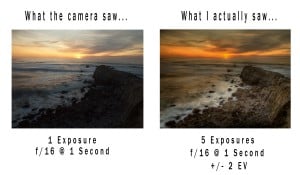3+ Hours on Everything You NEED to know to become an HDRtist Today!
HDR is short for High Dynamic Range Imaging, actually HDRI, but HDR is typically what you see in the industry and around the web. So what exactly is High Dynamic Range Imaging? It is the process of combining multiple exposures of a scene to create one image that displays all of the luminance information gathered in the multiple exposures.
The exposures are processed using software specifically designed for HDR processing. The current HDR software leaders are Photomatix Pro and HDR Efex Pro. A process called tone mapping is required to translate the processed HDR image into a usable 8 bit (.jpg) or 16 bit (.tif) image. During the tone mapping phase you have complete control over the contrast, detail, saturation, and luminosity to mention a few. Here is a great resource to dive further into the numbers and math behind the inner workings of high dynamic range.
If you are a photographer already you are probably thinking, “Alright I’m getting it”, while the average Joe is thinking, “You had me at HDR is short for what?” Here is an example for you:
Have you ever been breath taken by a beautiful sunset over the ocean, so moved by its beauty that you took out any device that could possible capture its magnificence? Awe inspired by its glamor you can’t wait to get home and look at it on your monitor. The anticipation of possibly seeing it once again is tugging on your heart strings, your mouth is watering as you plug your camera into your computer. The window pops up, “What would you like to do with this removable storage device”. You are thinking, “Anything computer, do anything with it just show me the magnificently contrasted, beautifully colored, well composed epic photograph that so mystically captivated my soul and just may possibly be the bane of my existence!”
And…..
There it is, the washed out low contrast, image of an ugly ocean and its incompatible sunset. The reds look like half breed cousins of the awful orange next door. Instead of the vibrant cyan sea foam coated ocean, you are left with moody blues. Your lively dancing greens appear to be taking the day off showing you their muddy backsides. Your image is not as you saw it, you try to imagine that it is by showing it off, thinking maybe someone will see it like I did, but their expression doesn’t seem to capture an ounce of the awe inspired sunset juice that recently passed through your heart.
This my friends is where HDR comes right in to save the day and swoop you off your feet. Check out the variations below:
You can see that by taking 5 separate photographs and manipulating the amount of contrast, saturation, detail, and luminosity you can achieve a more accurate depiction of the vibrant scene that you recently saw. The image on the left is straight out of the camera, no editing, as you can see I didn’t even straighten the horizon! The second picture shows you more of what I actually saw, but I needed the HDR process to achieve the finished image.
[hcshort id=”5″]



